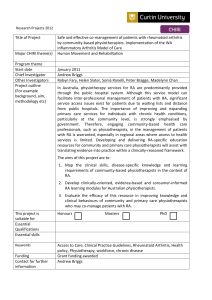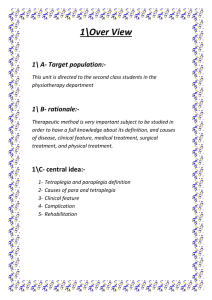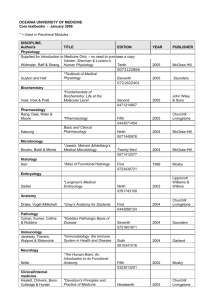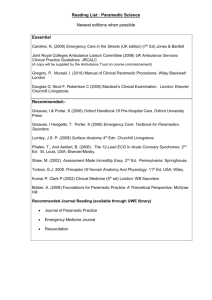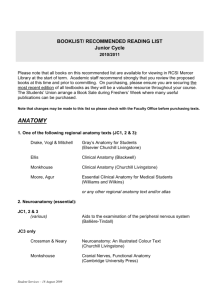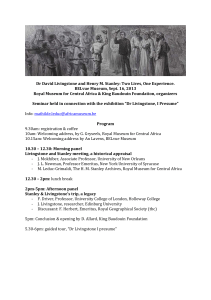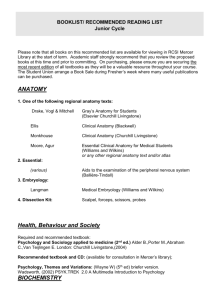การขนย้ายผู้ป่วย อุปกรณ์ช่วยเดิน
advertisement
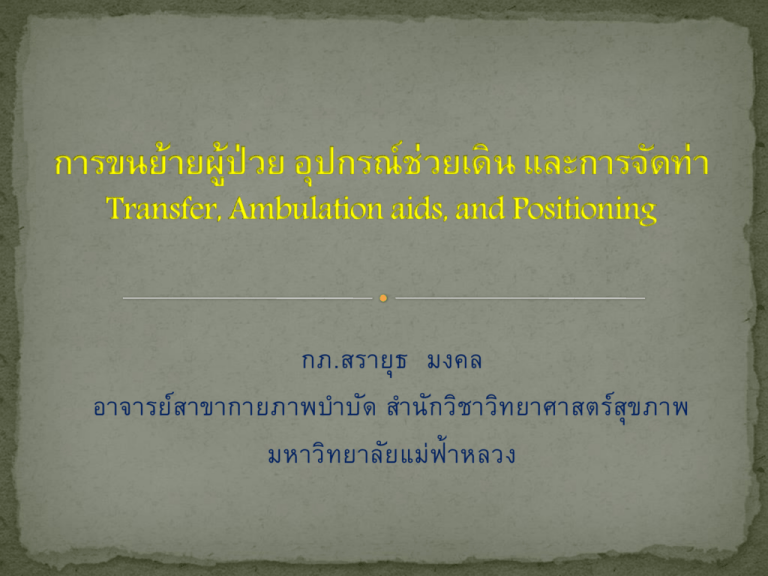
กภ.สรายุธ มงคล อาจารย์ส าขากายภาพบาบัด สานักวิช าวิท ยาศาสตร์สุขภาพ มหาวิท ยาลัยแม่ฟ้ าหลวง Part1; Transfer Part2; Ambulation aids Part3; Positioning The SAFE movement of a person from one surface or location to another or from one position to another •Tetraplegia and Paraplegia (A Guide for Physiotherapists). 5th ed. London: Churchill Livingstone. 2005 Select, position, and secure needed equipment; apply a safety belt on the patient Instruct the patient how to perform the transfer; demonstrate the transfer as necessary Practice components of the transfer as necessary before attempting the entire transfer Watch pt for orthostatic hypotension ? Symptoms: dizzy, faint, blurred vision, slurred speech Stand slowly, deep breaths, talk during transfer.. •Tetraplegia and Paraplegia (A Guide for Physiotherapists). 5th ed. London: Churchill Livingstone. 2005 Position yourself to guard and protect the patient throughout the transfer -- Do not guard the patient by using his/her clothing or grasping his/her arm Request the patient to initiate and perform the transfer; assist him/her as necessary Guide and direct the patient throughout the transfer and closely guard him/her Be alert for unusual events that may occur •Tetraplegia and Paraplegia (A Guide for Physiotherapists). 5th ed. London: Churchill Livingstone. 2005 # Avoid simultaneous trunk bending (flexion) and twisting (rotation) # Stoop or squat to reach for and lift an object below waist level # Stand on a stable foot stool or ladder to reach for an object above shoulder level •Tetraplegia and Paraplegia (A Guide for Physiotherapists). 5th ed. London: Churchill Livingstone. 2005 # Apply pushing and pulling forces parallel to the surface over which the object is to be moved # Carry objects close to your center of gravity and close to the midline of the body •Tetraplegia and Paraplegia (A Guide for Physiotherapists). 5th ed. London: Churchill Livingstone. 2005 @ Carry a one-hand item alternately with your upper extremities @ Avoid using long lever arms to push, pull, lift, reach, and carry objects @ Perform push, pull, lift, reach, and carry activities within your physical capacity and limits Know when to ask for help!! •Tetraplegia and Paraplegia (A Guide for Physiotherapists). 5th ed. London: Churchill Livingstone. 2005 ศูนย์สาธิตอุปกรณ์เครือ่ งช่วยคนพิการ ศูนย์สริ นิ ธรเพือ่ การฟื้นฟูสมรรถภาพทางการแพทย์แห่งชาติ ความรูท้ วไปเกี ั่ ย่ วกับเก้าอี้ลอ้ เข็นและการช่วยเหลือเบือ้ งต้นแก่คนพิการทางกายและการเคลือ่ นไหวในการใช้ลอ้ เข็น ศูนย์สาธิตอุปกรณ์เครือ่ งช่วยคนพิการ ศูนย์สริ นิ ธรเพือ่ การฟื้นฟูสมรรถภาพทางการแพทย์แห่งชาติ ความรูท้ วไปเกี ั่ ย่ วกับเก้าอี้ลอ้ เข็นและการช่วยเหลือเบือ้ งต้นแก่คนพิการทางกายและการเคลือ่ นไหวในการใช้ลอ้ เข็น เทคนิคการเข็นถอยหลังลงพืน้ ที่ต่างระดับการเข็น เทคนิคการเข็นเดินหน้าลงพืน้ ทีต่ ่างระดับ ศูนย์สาธิตอุปกรณ์เครือ่ งช่วยคนพิการ ศูนย์สริ นิ ธรเพือ่ การฟื้นฟูสมรรถภาพทางการแพทย์แห่งชาติ ความรูท้ วไปเกี ั่ ย่ วกับเก้าอี้ลอ้ เข็นและการช่วยเหลือเบือ้ งต้นแก่คนพิการทางกายและการเคลือ่ นไหวในการใช้ลอ้ เข็น เทคนิคการเข็นเดินหน้ าขึน้ ทางต่างระดับ เทคนิคการเคลื่อนล้อเข็นขึน้ และลงทางลาดชัน แบบ 4 ล้อ ศูนย์สาธิตอุปกรณ์เครือ่ งช่วยคนพิการ ศูนย์สริ นิ ธรเพือ่ การฟื้นฟูสมรรถภาพทางการแพทย์แห่งชาติ ความรูท้ ั ่วไปเกีย่ วกับเก้าอี้ลอ้ เข็นและการช่วยเหลือเบื้องต้นแก่คนพิการทางกายและการเคลือ่ นไหวในการใช้ลอ้ เข็น เทคนิคการเคลือ่ นย้ ายผู้ป่วยลงบันได โดยใช้ รถเข็น เทคนิคการเคลือ่ นย้ ายผู้ป่วยขึน้ บันได โดยใช้ รถเข็น ศูนย์สาธิตอุปกรณ์เครือ่ งช่วยคนพิการ ศูนย์สริ นิ ธรเพือ่ การฟื้นฟูสมรรถภาพทางการแพทย์แห่งชาติ ความรูท้ ั ่วไปเกีย่ วกับเก้าอี้ลอ้ เข็นและการช่วยเหลือเบื้องต้นแก่คนพิการทางกายและการเคลือ่ นไหวในการใช้ลอ้ เข็น ศูนย์สาธิตอุปกรณ์เครือ่ งช่วยคนพิการ ศูนย์สริ นิ ธรเพือ่ การฟื้นฟูสมรรถภาพทางการแพทย์แห่งชาติ ความรูท้ ั ่วไปเกีย่ วกับเก้าอี้ลอ้ เข็นและการช่วยเหลือเบื้องต้นแก่คนพิการทางกายและการเคลือ่ นไหวในการใช้ลอ้ เข็น http://www.mountnittany.org/assets/images/krames/7626.jpg http://www.tpub.com/content/armymedical/MD0923/MD09230124im.jpg Advantage; High level of stability Disadvantage; Difficult to move Measureing; As same as cane http://medicalhardware.co.nz/images/ParallelBar.jpg Lightweight aluminum or wood Increase BOS and improve balance Hold a cane in the hand opposite the affected extremity Reduced reaction force •Tetraplegia and Paraplegia (A Guide for Physiotherapists). 5th ed. London: Churchill Livingstone. 2005 Made from aluminum, wood, or plastic A half circle handle and the distal rubber tip is at least 1 in. in diameter or larger Adjust from approximately 27 to 38.5 in. (68 to 98 cm.) Advantage; inexpensive and fits easily on stare or other surface Disadvantage; Not adjustable and point of support is anterior to the hand •Tetraplegia and Paraplegia (A Guide for Physiotherapists). 5th ed. London: Churchill Livingstone. 2005 Same as the standard cane but can adjustable Advantage; Quickly adjustable, light weight, and fits easily on stairs Disadvantage; Expensive > standard cane, and point of support is anterior to the hand •Tetraplegia and Paraplegia (A Guide for Physiotherapists). 5th ed. London: Churchill Livingstone. 2005 Shaft of cane is offset anterior creating a straight handle Adjust from approximately 27 to 38.5 in. (68 to 98 cm.) Advantage; The design allows pressure to be borne over the center of the cane for greater stability, quickly adjustable, lightweight, and fits easily Disadvantage; mostly expensive •Tetraplegia and Paraplegia (A Guide for Physiotherapists). 5th ed. London: Churchill Livingstone. 2005 There are large and small base quad canes Four point contract on the floor Adjust from approximately 28 to 38 in. (71 to 91 cm.) Advantage; Several different of a broad-based support, suitable for instability patients Disadvantage; difficult to use in stairs or other floor, Slow gait pattern •Tetraplegia and Paraplegia (A Guide for Physiotherapists). 5th ed. London: Churchill Livingstone. 2005 It provides a very broad base with four points of floor contact Adjust from approximately 29 to 37 in. (73 to 94 cm.) Advantage; very broad base, very stable Disadvantage; difficult to use in stairs or other floor, Slow gait pattern, expensive •Tetraplegia and Paraplegia (A Guide for Physiotherapists). 5th ed. London: Churchill Livingstone. 2005 It provides a wide wheeled base Adjust from approximately 28 to 37 in. (71 to 94 cm.) A pressure-sensitive break built in the handle Advantage; Easy to move, faster walking, assist to standing Disadvantage; Not stable for imbalance patient, expensive, Don’t used in hand weakness patients •Tetraplegia and Paraplegia (A Guide for Physiotherapists). 5th ed. London: Churchill Livingstone. 2005 It provides a very broad base with four points of floor contact Adjust from approximately 29 to 37 in. (73 to 94 cm.) Advantage; very broad base, very stable Disadvantage; difficult to use in stairs or other floor, Slow gait pattern, expensive •Tetraplegia and Paraplegia (A Guide for Physiotherapists). 5th ed. London: Churchill Livingstone. 2005 www.wheelchairaccess.co.uk/walking_aids.html http://www.rehabmart.com/imagesfromrd/KP-PRC-1.jpg Far from the lateral of toe about 6 in. Top of cane is approximately at greater trochanter Elbow should be flex about 20-30° •Tetraplegia and Paraplegia (A Guide for Physiotherapists). 5th ed. London: Churchill Livingstone. 2005 Used to improve balance and to either relieve weight bearing Used bilateral Increase BOS Improve lateral stability To allow the UEs to transfer body weight to the floor •Tetraplegia and Paraplegia (A Guide for Physiotherapists). 5th ed. London: Churchill Livingstone. 2005 Regular or standard crutches Lightweight wood or aluminum Axillary bar, a handpiece, and double upright joint Used screw mechanism Adjust from approximately 48 to 60 in. (122 to 153 cm.) •Tetraplegia and Paraplegia (A Guide for Physiotherapists). 5th ed. London: Churchill Livingstone. 2005 Advantage; Improve balance and lateral stability, can restricted weightbearing, Easy to adjusted, inexpensive, can used for stair climbing Disadvantage; be careful in small area, pressure at axillary area to damage the radial nerve •Tetraplegia and Paraplegia (A Guide for Physiotherapists). 5th ed. London: Churchill Livingstone. 2005 Forearm rests crutch Use in patients that don’t weightbearing in wrist and hand It has a dowel or handgrip, velcro strap to maintain the position of forearm Advantage; used in patient that don’t weightbearing in wrist and hand Disadvantage; expensive, difficult to move •Tetraplegia and Paraplegia (A Guide for Physiotherapists). 5th ed. London: Churchill Livingstone. 2005 Compose of a single upright, a forearm cuff, and a handgrip A push-button mechanism Adjust from approximately 29 to 35 in. (74 to 89 cm.) Advantage; Easy to upstairs, Easy to adjust, suitable for stable patients Disadvantage; expensive, difficult to remove cuff, less lateral support •Tetraplegia and Paraplegia (A Guide for Physiotherapists). 5th ed. London: Churchill Livingstone. 2005 Axillary crutches • Standing - Approximately 2 in. or the width of two fingers below axillary - Distal end of the crutch should be resting at 2 in lateral and 6 in anterior to the foot - Sholder relax, Elbow should be flex about 2030° •Tetraplegia and Paraplegia (A Guide for Physiotherapists). 5th ed. London: Churchill Livingstone. 2005 http://www.suncare-medical.com/UploadFile/2008126153220.jpg Axillary crutches • Supine - Measurement is taken from the anterior axillary fold to a surface point 6 to 8 in. (5 to 7.5 cm) from the lateral border of the heel •Tetraplegia and Paraplegia (A Guide for Physiotherapists). 5th ed. London: Churchill Livingstone. 2005 Forearm crutches • Standing; as same as axillery crutches - Cuff placement should be on the proximal third of the forearm, approximately 1 to 1.5 in.(2.5 to 3.8 cm) below the elbow •Tetraplegia and Paraplegia (A Guide for Physiotherapists). 5th ed. London: Churchill Livingstone. 2005 Used to improve balance and relieve weightbearing Greater stability and a wide BOS Improve anterior and lateral stability To allow the UEs to transfer body weight to the floor Adjust from approximately 32 to 37 in. (81 to 92 cm) Several design in other patients •Tetraplegia and Paraplegia (A Guide for Physiotherapists). 5th ed. London: Churchill Livingstone. 2005 Advantage; Greater stability, easy Disadvantage; Difficult to move in small area or upstairs, don’t used in hand weakness •Tetraplegia and Paraplegia (A Guide for Physiotherapists). 5th ed. London: Churchill Livingstone. 2005 Advantage; Easy to move forward, can used in impair hand weakness Disadvantage; Difficult to move in small area or upstairs, don’t stable •Tetraplegia and Paraplegia (A Guide for Physiotherapists). 5th ed. London: Churchill Livingstone. 2005 Allow unilateral forward progression of one side of the walker Advantage; High level of stability, lightweight, easy to adjust Disadvantage; Difficult to move in small area or upstairs, Cumbersome •Tetraplegia and Paraplegia (A Guide for Physiotherapists). 5th ed. London: Churchill Livingstone. 2005 http://www.caring-for-aging-parents.com/images/standard_walker.jpg As same as cane •Tetraplegia and Paraplegia (A Guide for Physiotherapists). 5th ed. London: Churchill Livingstone. 2005 Can move about 0-90° Improve standing Improve blood circulation Postural drainage Prevent osteoporosis 15-40 at first Abnormal sign; Decrease 5-10 Rest 5-10 minutes Strap at chest, hip, and above knee •Tetraplegia and Paraplegia (A Guide for Physiotherapists). 5th ed. London: Churchill Livingstone. 2005 http://internationalbrain.org/enews/issue1_07/Erigo_setup.jpg Non weight bearing (0%) Toe touch weight bearing (<20% body weight) Partial weight bearing (20-50% body weight) Weight bearing as tolerate (50-100% body weight) Full weight bearing (100%) •Tetraplegia and Paraplegia (A Guide for Physiotherapists). 5th ed. London: Churchill Livingstone. 2005 4 point gait 3 point gait 2 point gait Swing to gait Swing through gait Good stability - at least 3 point contact ground Ataxia or incoordination Slowest, difficulty •Tetraplegia and Paraplegia (A Guide for Physiotherapists). 5th ed. London: Churchill Livingstone. 2005 Non-weight-bearing gait for lower limb fracture or amputation •Tetraplegia and Paraplegia (A Guide for Physiotherapists). 5th ed. London: Churchill Livingstone. 2005 Faster than 4-point gait but less stability Decrease both lower limbs weight-bearing •Tetraplegia and Paraplegia (A Guide for Physiotherapists). 5th ed. London: Churchill Livingstone. 2005 Both crutches -> both lower limbs almost to crutch level •Tetraplegia and Paraplegia (A Guide for Physiotherapists). 5th ed. London: Churchill Livingstone. 2005 Fastest gait, requires functional abdominal muscles, good balance •Tetraplegia and Paraplegia (A Guide for Physiotherapists). 5th ed. London: Churchill Livingstone. 2005 http://www.pfiedler.com/1079/images/front3.jpg To promote comfort and relaxation To restore body function To prevent deformities To relieve pressure and prevent strain To stimulate circulation To give treatments Rraddom, R. et al. (2007). Physical medicine and rehabilitation 3rd edition Maintain good patient’s body alignment. Maintain the patient’s safety. Reassure the patient to promote comfort and cooperation. Properly handle the patient's body to prevent pain or injury. Keep in mind proper body mechanics for the practically. Obtain assistance, if needed, to move heavy or helpless patients. Do not use special devices (that is., splints, traction) unless ordered. Ask if you do not know what is allowed Rraddom, R. et al. (2007). Physical medicine and rehabilitation 3rd edition http://www.annals.org/content/123/6/433/F2.large.jpg http://www.moondragon.org/images/patientpositionsemisupine.jpg http://www.moondragon.org/images/patientpositionprone1.jpg http://www.moondragon.org/images/patientpositionsemiprone.jpg http://www.moondragon.org/images/patientpositionrightlateral.jpg กายภาพบาบัดผูป้ ่ วยอัมพาตครึ่งซีก http://www.tpub.com/content/armymedical/md0905/md09050101im.jpg กายภาพบาบัดผูป้ ่ วยอัมพาตครึ่งซีก กายภาพบาบัดผูป้ ่ วยอัมพาตครึ่งซีก Questions?
